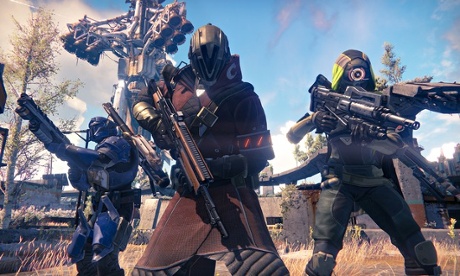
When the creator of Halo, Bungie, officially announced Destiny two years ago, it did not reveal a single game, it revealed a ten-year plan. According to the studio’s contract with Activision (which was revealed in full online due to the publisher’s legal battle with ex-Infinity Ward developers, Vince Zampanella and Jason West), the development team committed to at least a decade on the project. Now that the first game is out, how is that going to work?
In the original document, the idea was for Bungie to create four titles before 2023, one every two years, interspersed with big downloadable content updates. The narrative arc of the series is planned to run through it all. In a recent interview with Official Xbox Magazine, Destiny’s head of production, Jonty Barnes claimed that was just a framework and that we should not necessarily expect three more Destiny titles – or that everything will be over in a decade:
“So what I’ll say to you is: we said that we were a ten-year game, and both Activision and Bungie have committed to being wholly behind the large effort, and it’s a large investment for both sides. I don’t think there’s any set date – ten years is just representing the go-forward presence and the way that we think about doing things.”
We also know that at least two DLC expansion packs are on the way. The first, subtitled The Dark Below, will feature new co-op missions and crucible maps as well as fresh armour, weapons and other items – and its own mini story line. It will be out in December. A second, House of Wolves, will be along next year. Then a full sequel is likely.
Speaking to the Guardian at Gamescom, Barnes claimed that most of the creative staff had moved on to new content very early in 2014. “Much of this year has been about test and polish, bug fixing, stabilisation, making sure it was scaled ready for the beta,” he said. “Since February, most of our artists have actually been working on future versions of Destiny, starting the process of concept art again.”
A plan of action
So how does a studio plan ahead for such a long development period and a production line of content? “We love to invest in universes,” says the studio’s COO, Pete Parsons. “We did Halo for ten years we just didn’t have the benefit of knowing it would happen.
“Some of the planning has to do with technology – we don’t know where it is going – but we know we can future-proof around architecture and the kind of work loads we want our artists and designers to have. We have the concept of one world and multiple platforms – that’s not how development used to happen. Often you’d make a game for the Xbox 360 and port to the PS3 or vice versa. With Destiny, it doesn’t matter what platform its on, even if it’s on a companion, it’s sitting in one world – we don’t separate them. That’s a lot of planning.”
For Destiny, then, the focus has been on designing a flexible core architecture that the game designers, artists and writers don’t have to worry about – their tools stay the same; they can focus on creating. “In the future designers will be free from fighting their tools, fighting the pipelines, fighting the build, fighting the world server,” says Parsons. “They’re just there to make stuff.”
The inspiration for this approach comes from an interesting source: Pixar. Bungie has several staff who worked at the legendary animation studio and who brought with them the company’s approach to facilitating creation. “We know Pixar well and it’s interesting to talk to them because they have a lot of the same kinds of conversations that we do,” says Parsons.
“They’re focused on how do we get creators to create – how do we optimise the software for that? They have one advantage – they just need to get a frame then another, then another; we have to produce a frame then realise that the player can do whatever they want within that frame, it becomes incredibly complex. We have the same focus on developing our tools but the more we can plan ahead the more robust we can make them.”
As with other massive multiplayer games including World of Warcraft, there’s also a plan to populate the current iteration of the game with new content, non-playable characters and public competitions. The company has announced a series of events for September, and has promised:
Very soon, strange characters will arrive in the Tower with special offerings in hand. Public Events will erupt from the skies over your favorite destinations with greater frequency. And, Bungie will enter the fray with some bounties of our own for you to claim – if you can.
It’ll be welcome news to players who have found the game’s environments to be somewhat empty so far, and the Tower – its social hub – lacking any sense of bustle or intrigue. Whatever the future holds for Destiny, it has to work on getting the present functioning first.
“Part of the ongoing development process is also about watching players in the current game and learning what people like and what they don’t like. We need to understand player behaviours,” says Barnes. “Is there a convergence all going to one thing at once? What trends are we seeing? What activities do people like to do. What are the most successful public encounters? How do we broaden access? It’s not just about ensuring that the game runs well, it’s about informing future plans as well. It’s about what players like to do at what times of day.
“We always wanted to change the way people play cooperatively.”
- Destiny review: the future of games remains locked in the past
- Destiny – a non-gamer’s guide to 2014’s biggest game
- Destiny: how a universe was assembled by craftspeople and their community

